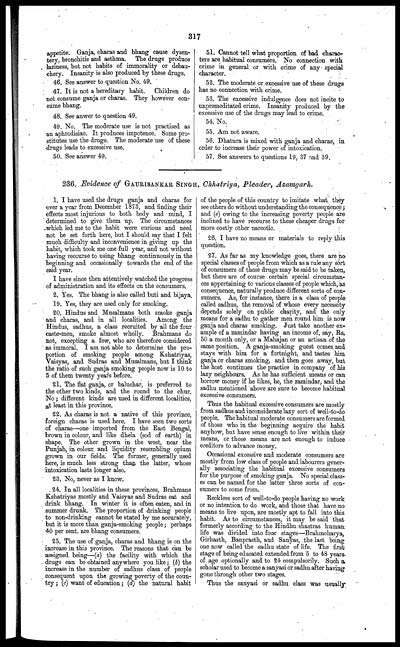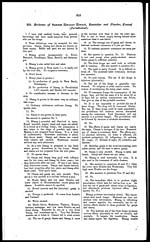Medicine - Drugs > Report of the Indian Hemp Drugs Commission, 1894-1895 > Volume V
(337) Page 317
Download files
Individual page:
Thumbnail gallery: Grid view | List view

317
appetite. Ganja, charas and bhang cause dysen-
tery, bronchitis and asthma. The drugs produce
laziness, but not habits of immorality or debau-
chery. Insanity is also produced by these drugs.
46. See answer to question No. 49.
47. It is not a hereditary habit. Children do
not consume ganja or charas. They however con-
sume bhang.
48. See anwer to question 49.
49. No. The moderate use is not practised as
an aphrodisiac. It produces impotence. Some pro-
stitutes use the drags. The moderate use of these
drugs leads to excessive use.
50. See answer 49.
51. Cannot tell what proportion of bad charac-
ters are habitual consumers. No connection with
crime in general or with crime of any special
character.
52. The moderate or excessive use of these drugs
has no connection with crime.
53. The excessive indulgence does not incite to
unpremeditated crime. Insanity produced by the
excessive use of the drugs may lead to crime.
54. No.
55. Am not aware.
56. Dhatura is mixed with ganja and charas, in
order to increase their power of intoxication.
57. See answers to questions 19, 37 and 39.
236. Evidence of GAURISANKAR SINGH, Chhatriya, Pleader, Azamgarh.
1. I have used the drugs ganja and charas for
over a year from December 1873, and finding their
effects most injurious to both body and mind, I
determined to give them up. The circumstances
which led me to the habit were curious and need
not be set forth here, but I should say that I felt
much difficulty and inconvenience in giving up the
habit, which took me one full year, and not without
having recourse to using bhang continuously in the
beginning and occasionally towards the end of the
said year.
I have since then attentively watched the progress
of administration and its effects on the consumers.
2. Yes. The bhang is also called buti and bijaya.
19. Yes, they are used only for smoking.
20. Hindus and Musalmans both smoke ganja
and charas, and in all localities. Among the
Hindus, sadhus, a class recruited by all the four
caste-men, smoke almost wholly. Brahmans do
not, excepting a few, who are therefore considered
as immoral. I am not able to determine the pro-
portion of smoking people among Kshatriyas,
Vaisyas, and Sudras and Musalmans, but I think
the ratio of such ganja smoking people now is 10 to
5 of them twenty years before.
21. The flat ganja, or baluchar, is preferred to
the other two kinds, and the round to the chur.
No; different kinds are used in different localities,
at least in this province.
22. As charas is not a native of this province,
foreign charas is used here. I have seen two sorts
of charas—one imported from the East Bengal,
brown in colour, and like dhela (sod of earth) in
shape. The other grown in the west, near the
Punjab, in colour and liquidity resembling opium
grown in our fields. The former, generally used
here, is much less strong than the latter, whose
intoxication lasts longer also.
23. No, never as I know.
24. In all localities in these provinces, Brahmans
Kshatriyas mostly and Vaisyas and Sudras eat and
drink bhang. In winter it is often eaten, and in
summer drunk. The proportion of drinking people
to non-drinking cannot be stated by me accurately,
but it is more than ganja-smoking people; perhaps
40 per cent. are bhang consumers.
25. The use of ganja, charas and bhang is on the
increase in this province. The reasons that can be
assigned being—(a) the facility with which the
drugs can be obtained anywhere you like; (b) the
increase in the number of sadhus class of people
consequent upon the growing poverty of the coun-
try; (c) want of education; (d) the natural habit
of the people of this country to imitate what they
see others do without understanding the consequence;
and (e) owing to the increasing poverty people are
inclined to have recourse to these cheaper drugs for
more costly other narcotic.
26. I have no means or materials to reply this
question.
27. As far as my knowledge goes, there are no
special classes of people from which as a rule any sort
of consumers of these drugs may be said to be taken,
but there are of course certain special circumstan-
ces appertaining to various classes of people which, as
consequence, naturally produce different sorts of con-
sumers. As, for instance, there is a class of people
called sadhus, the removal of whose every necessity
depends solely on public charity, and the only
means for a sadhu to gather men round him is now
ganja and charas smoking. Just take another ex-
ample of a zamindar having an income of, say, Its,
50 a month only, or a Mahajan or an artisan of the
same position. A ganja-smoking guest comes and
stays with him for a fortnight, and tastes him
ganja or charas smoking, and then goes away, but
the host continues the practice in company of his
lazy neighbours. As he has sufficient means or can
borrow money if he likes, he, the zamindar, and the
sadhu mentioned above are sure to become habitual
excessive consumers.
Thus the habitual excessive consumers are mostly
from sadhus and inconsiderate lazy sort of well-to-do
people. The habitual moderate consumers are formed
of those who in the beginning acquire the habit
anyhow, but have sense enough to live within their
means, or those means are not enough to induce
creditors to advance money.
Occasional excessive and moderate consumers are
mostly from low class of people and labourers gener-
ally associating the habitual excessive consumers
for the purpose of smoking ganja. No special class-
es can be named for the latter three sorts of con-
sumers to come from.
Reckless sort of well-to-do people having no work
or no intention to do work, and those that have no
means to live upon, are mostly apt to fall into this
habit. As to circumstances, it may be said that
formerly according to the Hindhu shastras human
life was divided into four stages—Brahmcharya,
Girhasth, Banprasth, and Sanyas, the last being
one now called the sadhu state of life. The first-
stage of being educated extended from 5 to 48 years
of age optionally and to 24 compulsorily. Such a
scholar used to become a sanyasi or sadhu after having
gone through other two stages.
Thus the sanyasi or sadhu class was usually
Set display mode to: Large image | Zoom image | Transcription
Images and transcriptions on this page, including medium image downloads, may be used under the Creative Commons Attribution 4.0 International Licence unless otherwise stated. ![]()
| India Papers > Medicine - Drugs > Report of the Indian Hemp Drugs Commission, 1894-1895 > Volume V > (337) Page 317 |
|---|
| Permanent URL | https://digital.nls.uk/75121839 |
|---|
| Description | Volume 5: Evidence of witnesses from North-Western Provinces and Oudh and Punjab. Answers from witnesses in North-Western Provinces, Oudh and Punjab about cultivation and growth of hemp, preparation or manufacture, trade, consumption or use, effects, administration - taxation and control. |
|---|---|
| Attribution and copyright: |
|




